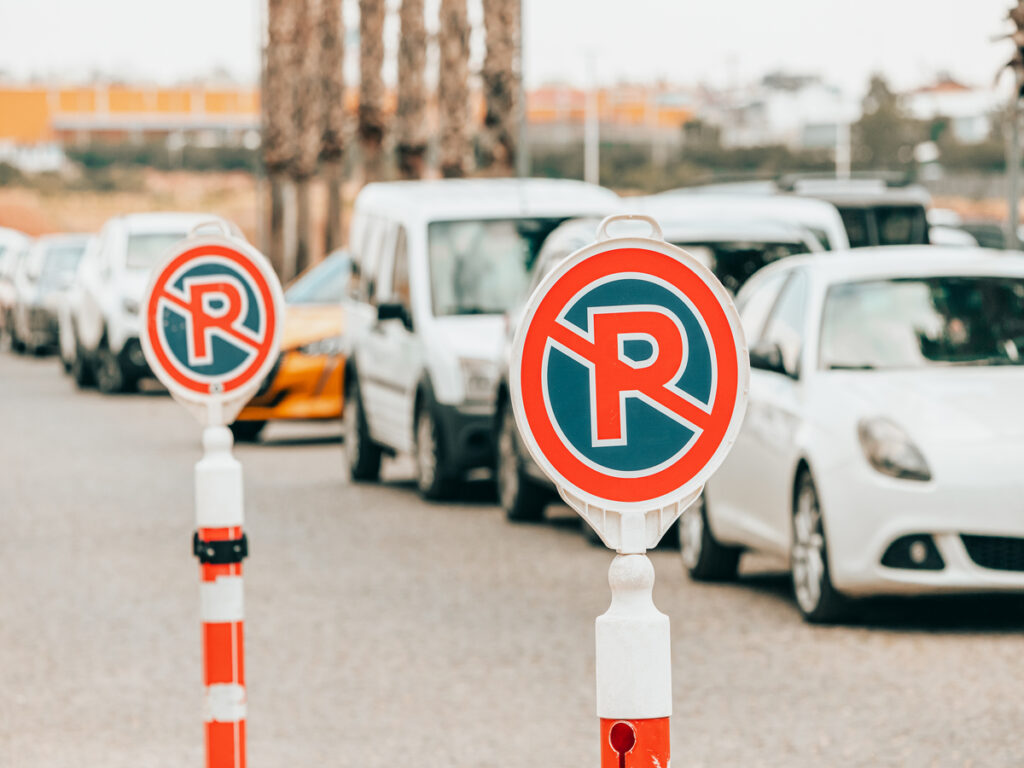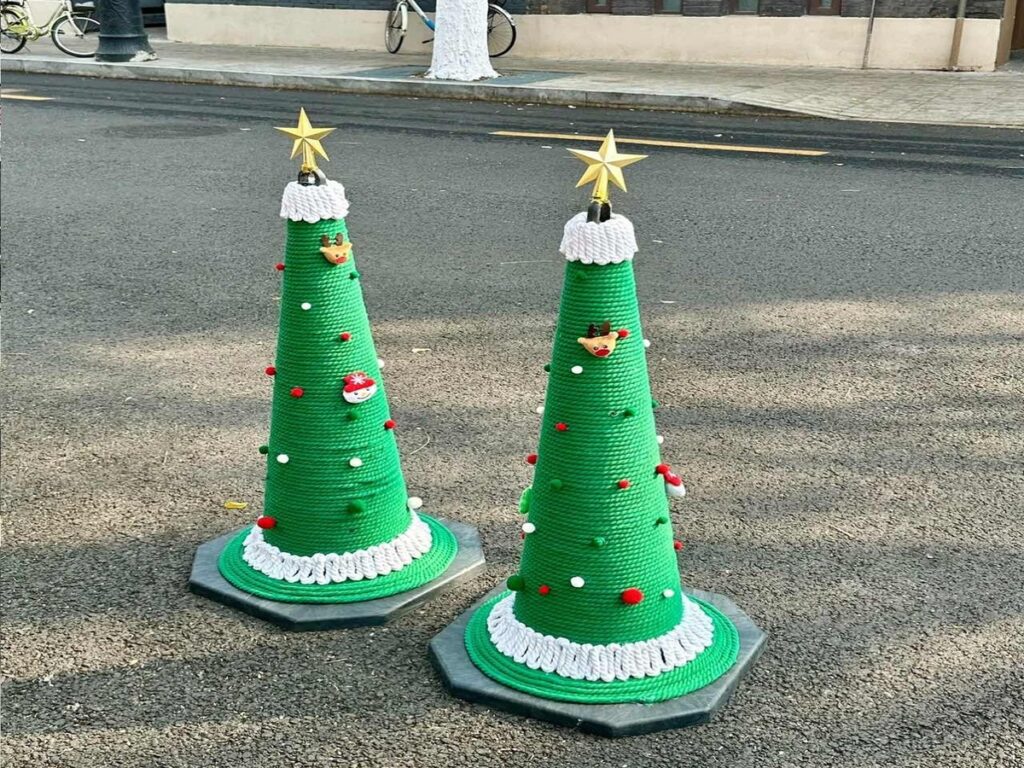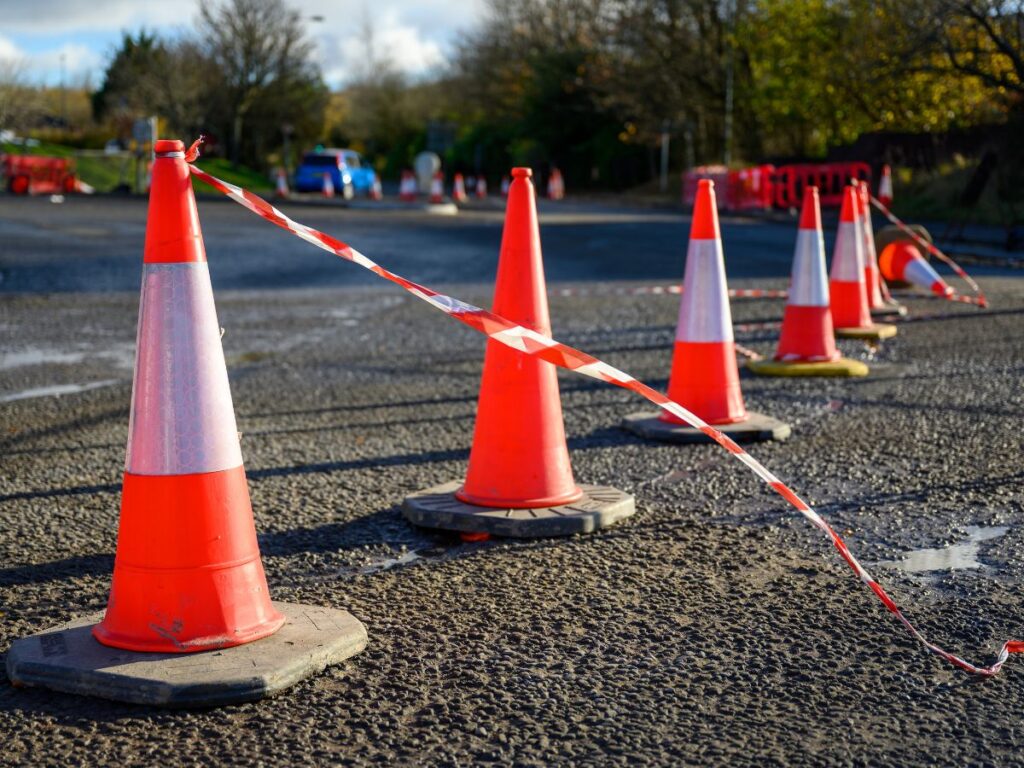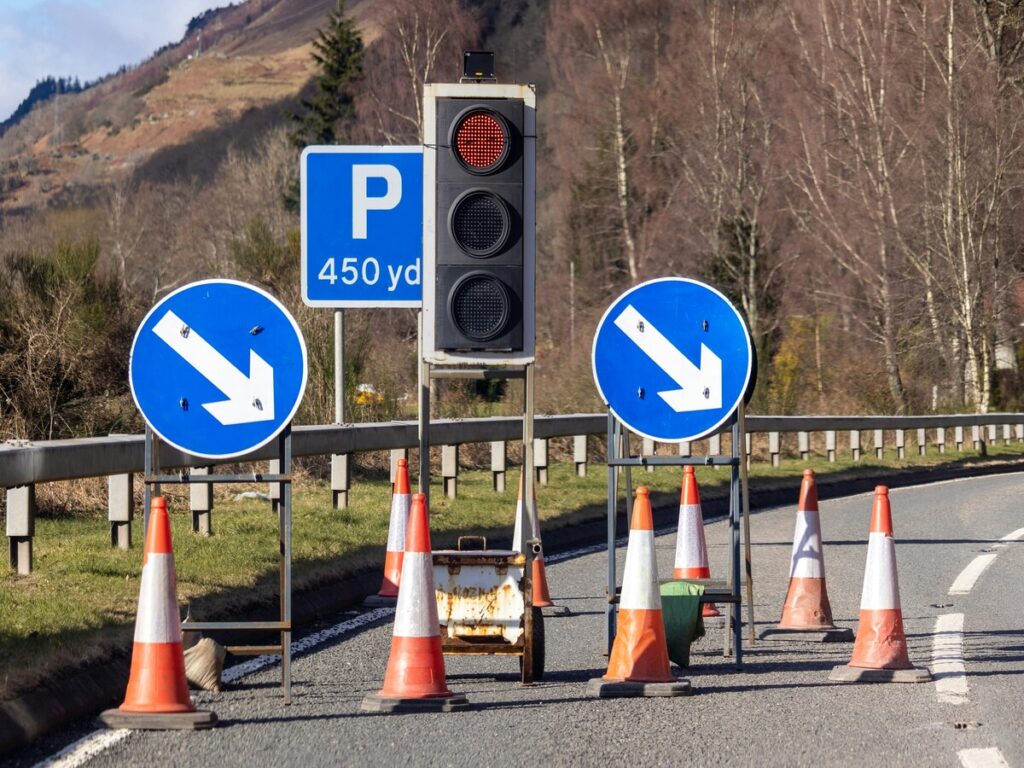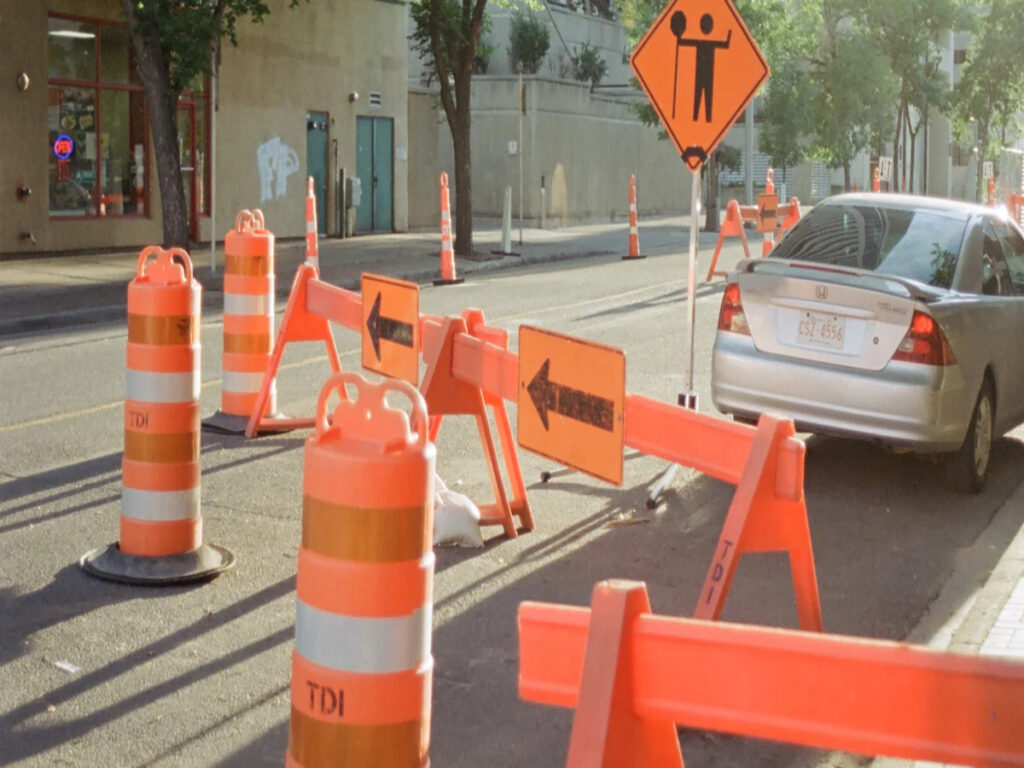
Panneaux de cône de trafic jouer un rôle vital pour assurer la sécurité et l'organisation des routes. Vous les voyez dans les zones de construction, détours, et les urgences, où ils fournissent une communication et des conseils clairs. Leur taille compacte les rend faciles à attacher aux cônes de trafic sans provoquer une instabilité. Les couleurs à haut contraste et les matériaux réfléchissants assurent la visibilité pendant la journée et la nuit. Ces panneaux de cône présentent également la messagerie concise, Aider les conducteurs et les piétons à réagir rapidement. Conçu pour une utilisation temporaire, Ils s'adaptent à diverses situations, des rues urbaines aux autoroutes. Le Département des transports repose sur ces outils polyvalents pour maintenir la sécurité dans les zones à haut risque.
Visibilité: La clé des signes de cône efficaces
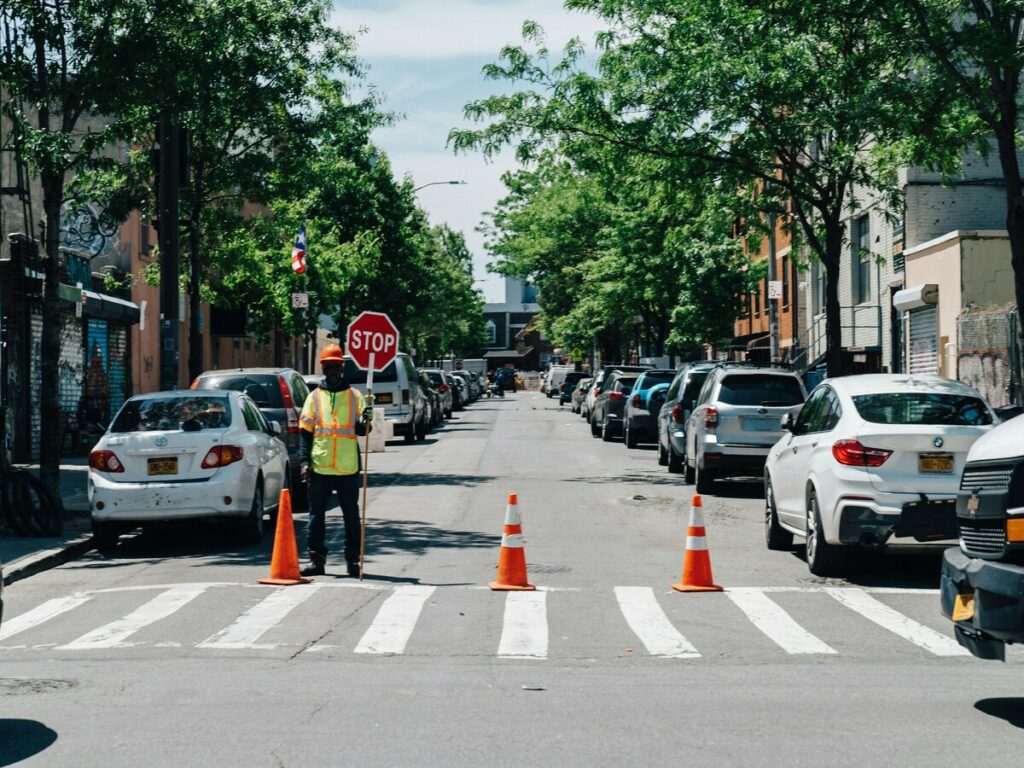
Couleurs à haut contraste et matériaux réfléchissants
Le rôle des couleurs fluorescentes comme l'orange pour attirer l'attention
Les couleurs fluorescentes comme l'orange et le vert lime sont essentielles pour les panneaux de cône de trafic. Ces couleurs se distinguent contre la plupart des environnements routiers, les rendant très efficaces dans les zones de construction et les détours. Orange vif, en particulier, Attrape l'attention rapidement, S'assurer que les conducteurs et les piétons remarquent les signes même dans les zones occupées ou chaotiques.
Comment les feuilles de réflexion améliorent la visibilité dans des conditions de faible luminosité
Les matériaux réfléchissants jouent un rôle crucial pour assurer la visibilité pendant la nuit ou les conditions de faible luminosité. Les panneaux de cône de circulation comportent souvent des bandes ou des revêtements réfléchissants qui rebondissent sur les phares du véhicule ou les lampadaires. Ces matériaux sont durables et résistent à un temps défavorable, les rendre fiables pour 24/7 utiliser. Les éléments réfléchissants sont particulièrement efficaces sur les autoroutes et dans les zones de contrôle du trafic temporaire, où la visibilité est critique pour la sécurité.
Caractéristiques illuminées pour une utilisation nocturne
L'intégration des lumières LED dans les panneaux de cône de circulation modernes
Les panneaux de cône de circulation modernes intègrent souvent des lumières LED pour améliorer la visibilité nocturne. Ces lumières offrent une lueur cohérente, Faire des signes de cône de sécurité visible même dans l'obscurité totale. Le NOUS. Ministère des Transports met en évidence l'efficacité de l'éclairage LED dans la réduction des accidents, conduisant à son adoption généralisée dans les projets d'infrastructure.
| Type de preuve | Description |
|---|---|
| Taux de décès nocturne | Trois fois plus élevé que les tarifs diurnes, avec 76% de décès piétons survenus la nuit. |
| Solutions de visibilité | Les matériaux à haute réflectivité et l'éclairage LED améliorent considérablement la sécurité pendant la nuit et les conditions météorologiques défavorables. |
Avantages des conceptions éclairées pour la sécurité nocturne
Les panneaux de cône de circulation illuminés améliorent la sécurité en réduisant le risque d'accidents. Les lumières LED combinées à des matériaux réfléchissants assurent une visibilité maximale, Même par temps défavorable. Ces fonctionnalités rendent les opérations nocturnes plus sûres pour les conducteurs et les travailleurs. Les cônes à haute visibilité se sont avérés réduire les taux d'accident, En faire un outil essentiel pour la gestion nocturne du trafic.
Signes OPT Offre de haute qualité cônes de circulation équipé de ces fonctionnalités avancées, Fournir une visibilité et une stabilité améliorées pour un large éventail d'applications de contrôle du trafic.
Placement optimisé
Placement stratégique pour une efficacité maximale
Le placement stratégique des panneaux de cône de trafic maximise leur impact. L'utilisation d'une formation de cône aide à guider les véhicules en douceur dans les voies ouvertes, réduire la confusion. Espacement approprié, comme placer des cônes de trafic 20 à pied, Crée une barrière cohérente pour le trafic. L'alignement des cônes assure également des allées et des détours clairs pour les piétons.
Adhérer aux directives de sécurité, comme ceux fournis par le Mutcd, S'assure que votre plan de gestion du trafic répond aux exigences légales et protège toutes les personnes impliquées.
Durabilité: Assurer des panneaux de cône de trafic durables
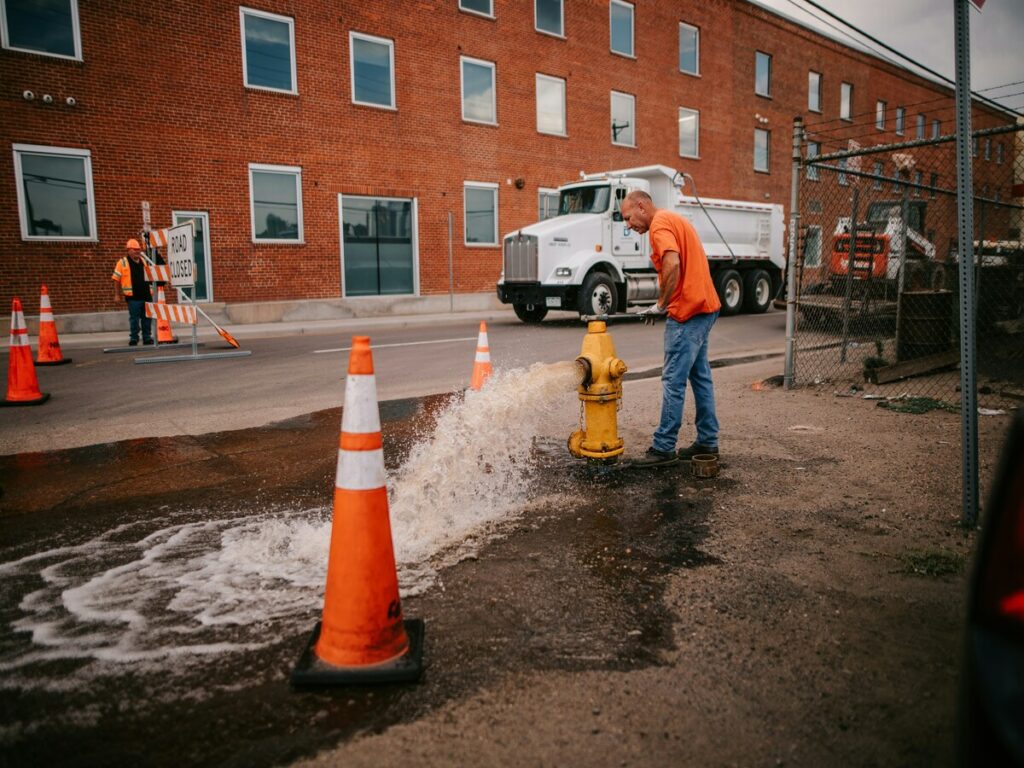
Matériaux résistants aux intempéries
L'utilisation de revêtements résistants aux UV pour éviter la décoloration
Les revêtements résistants aux UV jouent un rôle crucial dans le maintien des couleurs vibrantes des panneaux de cône de trafic. Ces revêtements protègent les matériaux des rayons ultraviolets nocifs, Empêcher la décoloration et la dégradation au fil du temps. Cela garantit que les panneaux de cône de sécurité restent visibles et efficaces, même après une exposition prolongée au soleil. Le Département des transports souligne l'importance de ces revêtements pour assurer la convivialité à long terme dans les environnements en plein air.
Matériaux qui résistent à des températures et des conditions météorologiques extrêmes
Les panneaux de cône de circulation doivent supporter une variété de conditions météorologiques, de la chaleur torride au glacial. Des matériaux comme le PVC et le caoutchouc sont couramment utilisés en raison de leur excellente résistance aux intempéries. Le PVC résiste à l'humidité et aux rayons UV, Maintenir sa couleur vive sous la lumière du soleil. Caoutchouc, d'autre part, offre une flexibilité et une durabilité, Le rendre adapté à une utilisation lourde.
Résistance à l'impact et flexibilité
Comment les matériaux flexibles comme le PVC garantissent la durabilité sous impact
Les cônes de trafic en PVC sont souvent appelés “cônes de trafic non recroquevables” En raison de leur capacité à se pencher lorsqu'il est heurté par un véhicule. Cette flexibilité minimise les dommages au cône et au véhicule, Assurer que le cône conserve sa forme et sa fonctionnalité au fil du temps. Le PVC résiste également à l'humidité et aux rayons UV, Préserver sa couleur orange vif et sa visibilité dans des conditions extérieures difficiles. Ces propriétés font du PVC un matériau idéal pour les panneaux de cône de trafic, s'assurer qu'ils restent fiables et efficaces dans des environnements à haut risque.
Test des normes de résistance à l'impact dans les environnements à haut risque
Les panneaux de cône de trafic subissent des tests rigoureux pour répondre aux normes de sécurité. Ces tests simulent les conditions du monde réel, comme les impacts des véhicules et les conditions météorologiques extrêmes, Pour s'assurer que les matériaux peuvent résister aux environnements à stress élevé. Des matériaux flexibles comme le PVC répondent constamment à ces normes, prouver leur durabilité et leur fiabilité dans des situations exigeantes.
Entretien et longévité
Caractéristiques de conception qui minimisent l'usure
Les panneaux de cône de trafic intègrent des fonctionnalités qui réduisent l'usure, comme les bords renforcés et les revêtements durables. Ces éléments de conception protègent les panneaux contre les dommages causés par une manipulation fréquente et un temps dur. En minimisant l'usure, Ces caractéristiques prolongent la durée de vie des panneaux de cône de sécurité, s'assurer qu'ils restent efficaces pendant des périodes plus longues.
Conseils pour maintenir les panneaux de cône de trafic pour une utilisation prolongée
Un bon entretien peut prolonger considérablement la durée de vie de vos panneaux de cône de trafic. Suivez ces conseils pour les garder en parfait état:
- Réparation des dommages mineurs: Fixez rapidement de petites fissures ou bosses en utilisant l'adhésif ou le scellant. Utilisez la chaleur pour remodeler les bosses.
- Nettoyage régulier: Laver avec du savon et de l'eau doux pour maintenir la visibilité. Ajustez la fréquence de nettoyage en fonction de l'environnement.
- Maintenance et stockage appropriés: Stocker les cônes verticaux dans une zone sèche pour éviter la déformation. Évitez la lumière directe du soleil et les températures extrêmes.
- Inspection de routine: Vérifiez régulièrement l'usure pour assurer la sécurité et l'efficacité.
En suivant ces pratiques, Vous pouvez vous assurer que vos panneaux de cône de trafic restent durables et fiables pour les années à venir.
Fonctionnalité: Faire des signes de cône de circulation
Design léger et portable
Caractéristiques qui facilitent le transport des panneaux de cône de trafic facile à transporter
Les panneaux de cône de trafic sont conçus avec la portabilité à l'esprit. Leur structure légère vous permet de les transporter sans effort, Les rendre idéaux pour un déploiement rapide en cas d'urgence. De nombreux modèles présentent des conceptions pliables, ce qui économise de l'espace et rend le stockage plus efficace. Ces fonctionnalités vous assurent de les transporter et de les stocker facilement, Même dans les espaces restreints. Haute visibilité, réalisé à travers des couleurs vives et des matériaux réfléchissants, améliore leur efficacité sur la route. En plus, Leur nature réutilisable offre une flexibilité pour divers scénarios de contrôle du trafic.
- Léger et facile à transporter pour un déploiement rapide.
- La structure pliable assure un stockage efficace.
- Une grande visibilité améliore la sécurité et la communication.
Configuration et suppression rapide pour les environnements dynamiques
Dans des environnements en évolution rapide, La configuration rapide et la suppression des panneaux de cône de trafic font gagner un temps précieux. Vous pouvez déplier et positionner ces signes de cône de sécurité en quelques secondes, vous permettant de vous adapter efficacement aux conditions changeantes. Leur conception légère rend l'attachement simple, Sans besoin d'outils spéciaux. Ce praticité garantit une communication claire des réglementations de la circulation, Même dans les configurations temporaires.
- Gagnez du temps avec un déploiement et un retrait rapide.
- La conception légère simplifie l'installation.
- Améliore la sécurité dans les scénarios de trafic dynamique.
Composants modulaires et personnalisables
Comment les conceptions modulaires permettent des messages interchangeables
Les panneaux de cône de trafic modulaire offrent une polyvalence inégalée. Vous pouvez facilement échanger des messages en fonction des différentes situations, Réduire le besoin de signes multiples. Ces conceptions simplifient le transport et le stockage, car les fonctionnalités empilables minimisent les exigences de l'espace. Leur durabilité garantit qu'ils résistent aux conditions difficiles, les rendre fiables pour une utilisation à long terme.
Options de personnalisation pour des besoins spécifiques et une marque
Les services de personnalisation vous permettent d'adapter les panneaux de cône de trafic vers vos besoins spécifiques. Vous pouvez choisir parmi une variété de couleurs, comme orange, vert citron, ou jaune, pour respecter les directives de l'industrie. L'ajout de logos ou de marque améliore la visibilité et la reconnaissance, tandis que les améliorations fonctionnelles garantissent que les panneaux de cône de sécurité répondent à vos exigences uniques. Ces options font des signes de cône de trafic outils polyvalents pour la sécurité et la marque.
- Couleurs personnalisables, y compris l'orange et le vert citron.
- Des options de marque comme les logos pour une reconnaissance améliorée.
- Améliorations fonctionnelles pour des applications spécifiques.
Compatibilité avec d'autres outils de sécurité
Intégration avec les barrières, escrime, et d'autres dispositifs de contrôle de la circulation
Les panneaux de cône de trafic s'intègrent parfaitement à d'autres outils de sécurité. Vous pouvez les attacher à barreaux, qui créent barrières physiques et améliorer la visibilité. Ces barres de cône de circulation rétractables, Disponible en couleurs vives, aider à prévenir efficacement les collisions et guider efficacement le trafic. Leur flexibilité vous permet de les ajuster facilement, les rendre adaptés aux situations dynamiques.
- Fixez-vous aux barres à cônes pour une visibilité améliorée.
- Les couleurs vives empêchent les collisions et guident le trafic.
- Les conceptions réglables offrent une flexibilité dans les configurations temporaires.
Exemples de conceptions multifonctionnelles de cône de trafic
Les conceptions de cône de trafic moderne intègrent des fonctionnalités avancées pour améliorer la convivialité. Certains cônes incluent désormais des caméras, charge sans fil, et alertes d'urgence. Ces innovations améliorent leur fonctionnalité, en faisant des outils précieux dans les systèmes de trafic intégrés. Ces conceptions multifonctionnelles reflètent la demande croissante de solutions de gestion du trafic plus intelligentes et plus efficaces.
Stabilité et adaptabilité: Répondre aux besoins divers
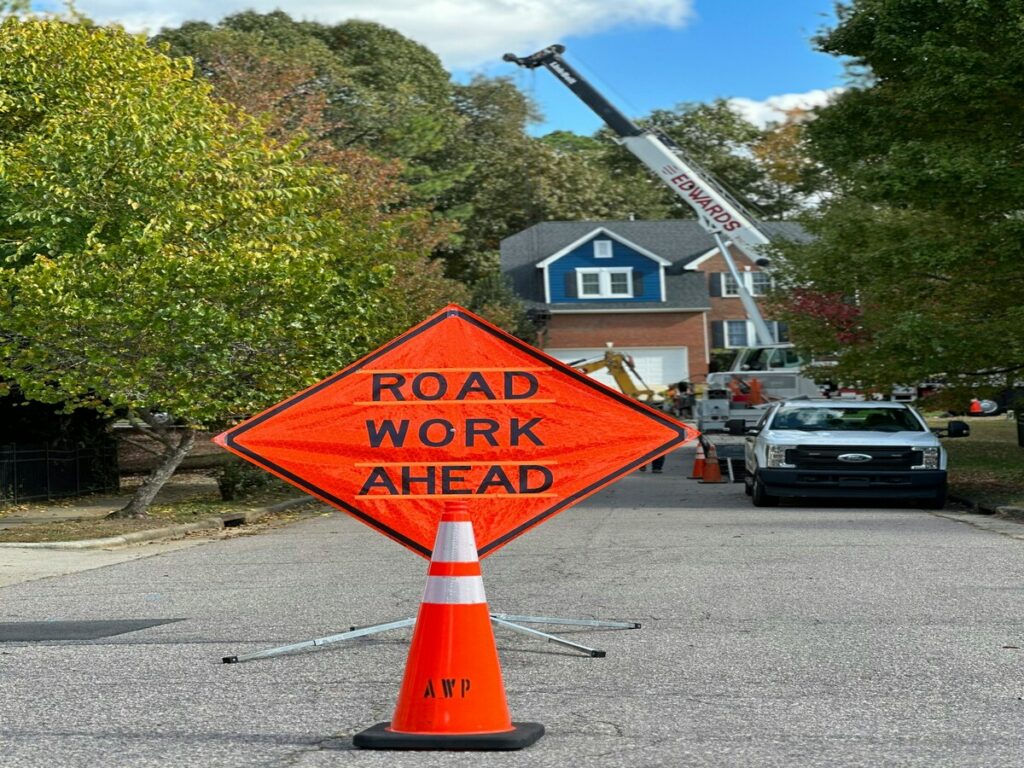
Mécanismes d'attachement pour la stabilité
Comment les sangles Velcro, œillets, et les machines à sous sécuriser les signes aux cônes
Les panneaux de cône de circulation reposent sur des mécanismes d'attachement sécurisés pour rester en place. STOCKES VELCRO, œillets, et les machines à sous s'assurent que les panneaux de cône de sécurité s'adaptent parfaitement sur le haut du cône. Ces caractéristiques empêchent les panneaux de cône de sécurité de glisser ou de détacher, Même dans des conditions venteuses ou lorsqu'elles sont heurtées par des véhicules. Vous pouvez faire confiance à ces mécanismes pour maintenir les panneaux de cône de sécurité stables, Assurer une communication claire dans les zones à haut risque.
Solutions d'ingénierie pour résister au vent et au mouvement
Les ingénieurs conçoivent des panneaux de cône de trafic pour résister efficacement au vent et au mouvement. Les mécanismes d'attachement distribuent la pression uniformément, réduire le risque de détachement. Cette stabilité garantit que les signes du cône de sécurité restent visibles et fonctionnels, Même dans des environnements difficiles. Vous pouvez compter sur ces solutions pour maintenir la sécurité et l'ordre pendant le contrôle temporaire du trafic.
Compatibilité avec différents cônes de trafic
Conceptions réglables pour différentes tailles et hauteurs de cône
Les panneaux de cône de trafic sont compatibles avec des cônes de différentes tailles et hauteurs. Les conceptions réglables vous permettent d'utiliser le même signe sur des cônes allant de 12 pouces à 28 pouces. Cette polyvalence les rend idéaux pour divers scénarios de contrôle du trafic.
| Fonctionnalité | Description |
|---|---|
| Taille compacte | Panneaux routiers plus petits que traditionnels, Permettre une fixation facile sans instabilité. |
| Mécanisme d'attachement | Le mécanisme spécialisé garantit la stabilité même dans des conditions venteuses ou lorsqu'elles sont heurtées par des véhicules. |
| Haute visibilité | Conçu avec des couleurs à contraste élevé pour une visibilité maximale dans diverses conditions d'éclairage. |
| Messagerie claire | Les messages concises et clairs transmettent rapidement les informations essentielles. |
| Utilisation temporaire | Idéal pour les scénarios de contrôle du trafic temporaire, facilement configuré et supprimé. |
Caractéristiques pour la stabilité sur un terrain inégal ou rugueux
Un terrain inégal peut poser des défis pour les panneaux de cône de circulation. Pour aborder cela, Les fabricants intègrent des fonctionnalités comme les bases pondérées et les accessoires flexibles. Ces conceptions garantissent que les cônes restent verticaux, Même sur des surfaces rugueuses. Vous pouvez utiliser en toute confiance ces panneaux dans les zones de construction, zones rurales, ou paramètres hors route.
Adaptabilité aux environnements et conditions
Considérations de conception pour urbain, rural, et paramètres hors route
Les panneaux de cône de trafic s'adaptent à divers environnements, des rues urbaines animées aux routes rurales éloignées. Des couleurs vives comme l'orange et le jaune assurent la visibilité dans tous les paramètres. Les matériaux réfléchissants améliorent la visibilité nocturne, tandis que les matériaux durables résistent au temps et au terrain sévères.
Adaptations saisonnières pour la neige, pluie, et chaleur extrême
Les conditions saisonnières exigent des panneaux de cône de circulation spécialisés. En hiver, Vous pouvez utiliser des panneaux de cône comme «Attention: Slippery quand il est glacé "pour avertir des routes glacées. Les panneaux de cône réfléchissants améliorent la visibilité pendant les tempêtes de neige ou les fortes pluies. Pour une chaleur extrême, Les matériaux durables empêchent la déformation ou la décoloration.
- Dangers hivernaux: Installez des panneaux comme «Attention: Slippery quand glacial "pour avertir des conditions glaciales.
- Accumulation de neige: Utiliser «AVERTISSEMENT: Falling Ice "Signes pour alerter les risques de l'accumulation de neige.
- Problèmes de visibilité: Des signes réfléchissants tels que «prudence: Faible visibilité à venir »Aide à des conditions de lumière du jour réduites.
- Équipement surgelé: Des signes comme «AVERTISSEMENT: L'équipement peut être gelé », rappelez aux travailleurs de vérifier les machines avant utilisation.
Ces adaptations garantissent la sécurité et les fonctionnalités de toute saison ou environnement.
Innovations dans la conception des panneaux de cône de trafic
Intégration de la technologie intelligente
L'utilisation des fonctionnalités IoT et solaire dans les conceptions modernes
Les panneaux de cône de circulation modernes incorporent désormais IoT et Technologie à énergie solaire pour améliorer les fonctionnalités et la durabilité. Les cônes compatibles IoT surveillent en continu les conditions de la route et les modèles de circulation, Partage de données en temps réel avec les systèmes de gestion du trafic. Cela vous permet de répondre rapidement aux dangers, Améliorer la sécurité routière. Les caractéristiques à énergie solaire réduisent la dépendance à l'électricité traditionnelle, rendre ces cônes éconergétiques et rentables. Vous pouvez les déployer dans des régions éloignées sans infrastructure électrique, Assurer l'accessibilité dans divers environnements.
| Avantage | Description |
|---|---|
| Efficacité énergétique et durabilité | Réduit la dépendance à l'électricité conventionnelle, réduire les émissions de carbone et promouvoir la durabilité. |
| Rentabilité | Élimine les besoins de câblage étendus, Réduire les coûts d'installation et de maintenance. |
| Visibilité et sécurité améliorées | Utilise une technologie LED lumineuse pour une visibilité claire, Améliorer la sécurité routière pendant la journée et la nuit. |
| Polyvalence et accessibilité | Peut être installé dans des emplacements éloignés sans infrastructure électrique traditionnelle. |
Les cônes intelligents comportent également des capteurs intégrés qui détectent les changements dans les conditions routières. Ces capteurs fournissent des alertes en temps réel sur les dangers, Vous aider à prendre des décisions plus sûres. Par exemple, Si un cône détecte un accident, Il peut immédiatement informer les autorités et activer les feux d'avertissement pour alerter les conducteurs. Cette approche proactive réduit les temps de réponse et empêche d'autres accidents.
Avantages des panneaux de cône de trafic intelligent pour les mises à jour en temps réel
Les signes de cône de trafic intelligent révolutionnent la gestion du trafic en fournissant des mises à jour en temps réel. Ces systèmes collectent en continu des données sur les conditions routières, modèles de trafic, et les dangers potentiels. Ils transmettent ces informations aux systèmes de gestion du trafic, activer les ajustements dynamiques aux signaux de circulation et optimisation du flux de trafic. Vous bénéficiez d'alertes sur les ralentissements ou le trafic arrêté à l'avance, vous permettant de planifier des itinéraires plus sûrs. Les cônes intelligents s'intègrent également de manière transparente aux systèmes de villes intelligentes, Assurer une communication efficace et un mouvement de trafic plus fluide.
Durabilité dans la conception
Matériaux écologiques pour la gestion durable du trafic
La durabilité devient une priorité dans la conception des panneaux de cône de trafic. Les fabricants utilisent désormais des matériaux recyclables comme polyéthylène (PE) et caoutchouc, qui contribuent aux pratiques écologiques. Dans 2024, L'industrie s'est déplacée vers des matériaux biodégradables tels que la forte résistance polypropylène (Pp). Ce matériau durable et recyclable réduit l'impact environnemental tout en maintenant la fiabilité des panneaux de cône de trafic. Les fournisseurs intègrent également des plastiques recyclés pour répondre aux consommateurs soucieux de l'environnement, Alignement avec les objectifs mondiaux de durabilité.
Tendances de la réduction de l'impact environnemental par la conception
L'industrie du cône de circulation adopte des moyens innovants pour minimiser l'impact environnemental. Vous remarquerez une utilisation croissante des matériaux recyclables et biodégradables, comme pp, dans les produits de sécurité routière. Des entreprises comme 3M ouvrent la voie en intégrant des matériaux durables dans leurs conceptions. Cette tendance reflète une demande croissante de solutions écologiques dans la gestion du trafic. En priorisant la durabilité, Les fabricants répondent aux besoins des consommateurs soucieux de l'environnement tout en réduisant leur empreinte carbone.
- Les matériaux recyclables et biodégradables deviennent standard.
- Les entreprises intègrent des matériaux durables pour s'aligner sur les normes environnementales.
- Les fournisseurs priorisent les options écologiques pour réduire l'impact environnemental.
Le Département des transports soutient ces progrès, Veiller à ce que les solutions de gestion du trafic restent efficaces et respectueuses de l'environnement.
Les panneaux de cône de trafic présentent une ingénierie exceptionnelle, Mélanger la visibilité, durabilité, et l'adaptabilité pour répondre à vos besoins de gestion du trafic. Leur conception garantit la sécurité dans divers environnements, Des autoroutes très fréquentées aux zones de construction. Vous pouvez compter sur ces outils pour fournir une communication claire et réduire les risques dans les zones à haut risque. À mesure que la technologie progresse, Les panneaux de cône continueront d'évolution, Offrir des solutions plus intelligentes et plus durables pour la sécurité routière. Leur rôle dans le contrôle du trafic reste indispensable, Assurer des routes plus sûres pour tout le monde.

